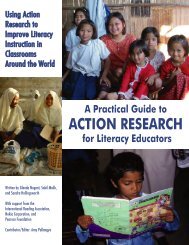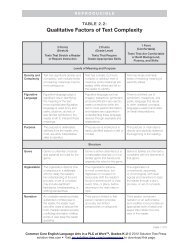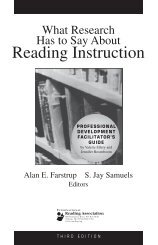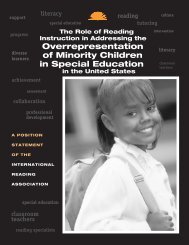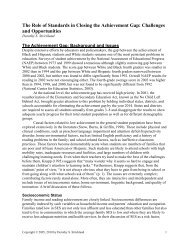Global Education Digest 2012 - International Reading Association
Global Education Digest 2012 - International Reading Association
Global Education Digest 2012 - International Reading Association
You also want an ePaper? Increase the reach of your titles
YUMPU automatically turns print PDFs into web optimized ePapers that Google loves.
OPPORTUNITIES LOST: THE IMPACT OF GRADE REPETITION AND EARLY SCHOOL LEAVING<br />
Expenditure on education<br />
Total public expenditure on education. The sum of all expenditure on education and education<br />
administration made by local, regional and national/central governments, including municipalities.<br />
Intergovernmental transfers are excluded.<br />
Current expenditure on education. Expenditure for goods and services consumed within the current<br />
year and which would be renewed if needed in the following year. It includes expenditure on staff salaries,<br />
pensions and benefits; contracted or purchased services; other resources, including books and teaching<br />
materials; welfare services; and other current expenditure, such as subsidies for students and households,<br />
minor equipment, minor repairs, fuel, telecommunications, travel, insurance and rent.<br />
Capital expenditure on education. Expenditure for assets that yield benefits for a period of more than<br />
one year. It includes expenditure for construction, renovation and major repairs of buildings and the<br />
purchase of heavy equipment or vehicles.<br />
Public subsidies. Public subsidies to households and other private entities consist of transfers to the<br />
private sector for educational institutions and transfers for student living costs and other education-related<br />
costs that occur outside educational institutions.<br />
Public subsidies to households and other private entities for educational institutions are composed of<br />
government transfers and certain other payments to students or households, insofar as these translate<br />
into payments to educational institutions for educational services (for example, fellowships, financial aid or<br />
student loans for tuition). They also include government transfers and other payments (mainly subsidies)<br />
to private entities other than households, including, for example, subsidies to firms or labour organizations<br />
that operate apprenticeship programmes and interest subsidies to private financial institutions that provide<br />
student loans, etc.<br />
Public subsidies to households that are not attributable to payments to educational institutions include<br />
subsidies for student living costs and the value of special subsidies provided to students, either in cash or<br />
in kind, such as free or reduced-price travel on public transport or family allowances that are contingent on<br />
student status.<br />
Fields of education (broad)<br />
Science and technology fields<br />
Science:.life sciences; physical sciences; mathematics and statistics; computer sciences.<br />
Engineering, manufacturing and construction:.engineering and engineering trades; manufacturing and<br />
processing; architecture and building.<br />
Other fields<br />
Agriculture:.agriculture, forestry and fishery; veterinary medicine.<br />
<strong>Education</strong>:.teacher training; education science.<br />
Health and welfare:.medicine; medical services; nursing; dental services; social care; social work.<br />
Humanities and arts:.religion and theology; foreign languages and cultures; native languages;<br />
interpretation and translation; linguistics; comparative literature; history; archaeology; philosophy; ethics.<br />
Fine arts; performing arts; graphic and audio-visual arts; design; craft skills.<br />
65



